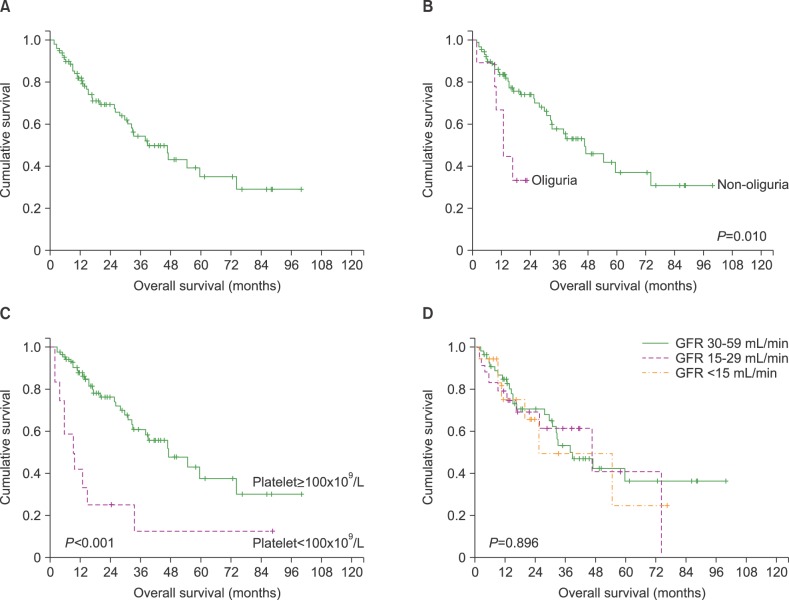Blood Res.
2015 Sep;50(3):167-172. 10.5045/br.2015.50.3.167.
Oliguria as an early indicator of mortality risk in patients with multiple myeloma and renal impairment
- Affiliations
-
- 1Department of Hematology-Oncology, Chonnam National University Hwasun Hospital, Hwasun, Korea. drjejung@chonnam.ac.kr
- KMID: 2172760
- DOI: http://doi.org/10.5045/br.2015.50.3.167
Abstract
- BACKGROUND
A change in urine output has been recently recognized as a valuable biomarker of acute kidney injury that is associated with mortality in critically ill patients. We investigated the prognostic impact of oliguria for survival outcomes in multiple myeloma (MM) patients presenting with renal impairment (RI).
METHODS
Retrospective data on 98 patients with MM and RI, who received initial treatment with novel therapies, were analyzed. Oliguria was defined as a urine output of <0.5 mL/kg/h.
RESULTS
The baseline median eGFR was 39.7 mL/min (range, 5.1-59.8). Achievement of renal complete response (CR) was observed in 39.8% of patients. Nine patients (9.2%) presented with oliguria at initial diagnosis, and 4 initially required dialysis. Over a median follow-up period of 17.1 months (range, 1.7-100.0), the median overall survival (OS) was 38.7 months (95% CI 25.0-52.5). Multivariate analyses indicated that oliguria at diagnosis [hazard ratio (HR) 3.628, 95% CI 1.366-9.849, P=0.011], and thrombocytopenia <100x10(9)/L at diagnosis (HR 2.534, 95% CI 1.068-6.015, P=0.035), were significantly associated with overall survival.
CONCLUSION
Oliguria was significantly associated with higher mortality in MM patients with RI. Therefore, close monitoring of urine output could be important for these patients.
Keyword
MeSH Terms
Figure
Cited by 1 articles
-
Chemotherapy adherence is a favorable prognostic factor for elderly patients with multiple myeloma who are treated with a frontline bortezomib-containing regimen
Hee-Jeong Cho, Sang-Kyung Seo, Dong Won Baek, Sung-Woo Park, Yoo-Jin Lee, Sang-Kyun Sohn, Ho-Sup Lee, Won Sik Lee, Ji Hyun Lee, Sung Hyun Kim, Joon-Ho Moon
Yeungnam Univ J Med. 2018;35(1):76-83. doi: 10.12701/yujm.2018.35.1.76.
Reference
-
1. Kyle RA, Gertz MA, Witzig TE, et al. Review of 1027 patients with newly diagnosed multiple myeloma. Mayo Clin Proc. 2003; 78:21–33. PMID: 12528874.
Article2. Eleutherakis-Papaiakovou V, Bamias A, Gika D, et al. Renal failure in multiple myeloma: incidence, correlations, and prognostic significance. Leuk Lymphoma. 2007; 48:337–341. PMID: 17325894.3. Davenport A, Merlini G. Myeloma kidney: advances in molecular mechanisms of acute kidney injury open novel therapeutic opportunities. Nephrol Dial Transplant. 2012; 27:3713–3718. PMID: 23114897.
Article4. Clark AD, Shetty A, Soutar R. Renal failure and multiple myeloma: pathogenesis and treatment of renal failure and management of underlying myeloma. Blood Rev. 1999; 13:79–90. PMID: 10414944.
Article5. Torra R, Bladé J, Cases A, et al. Patients with multiple myeloma requiring long-term dialysis: presenting features, response to therapy, and outcome in a series of 20 cases. Br J Haematol. 1995; 91:854–859. PMID: 8547129.
Article6. Augustson BM, Begum G, Dunn JA, et al. Early mortality after diagnosis of multiple myeloma: analysis of patients entered onto the United Kingdom Medical Research Council trials between 1980 and 2002--Medical Research Council Adult Leukaemia Working Party. J Clin Oncol. 2005; 23:9219–9226. PMID: 16275935.
Article7. Alexanian R, Barlogie B, Dixon D. Renal failure in multiple myeloma. Pathogenesis and prognostic implications. Arch Intern Med. 1990; 150:1693–1695. PMID: 2383164.
Article8. Dimopoulos MA, Roussou M, Gkotzamanidou M, et al. The role of novel agents on the reversibility of renal impairment in newly diagnosed symptomatic patients with multiple myeloma. Leukemia. 2013; 27:423–429. PMID: 22763386.
Article9. Dimopoulos MA, Delimpasi S, Katodritou E, et al. Significant improvement in the survival of patients with multiple myeloma presenting with severe renal impairment after the introduction of novel agents. Ann Oncol. 2014; 25:195–200. PMID: 24356630.
Article10. Cruz DN, Mehta RL. Acute kidney injury in 2013: Breaking barriers for biomarkers in AKI-progress at last. Nat Rev Nephrol. 2014; 10:74–76. PMID: 24375051.11. Macedo E, Malhotra R, Claure-Del Granado R, Fedullo P, Mehta RL. Defining urine output criterion for acute kidney injury in critically ill patients. Nephrol Dial Transplant. 2011; 26:509–515. PMID: 20562094.
Article12. Mandelbaum T, Lee J, Scott DJ, et al. Empirical relationships among oliguria, creatinine, mortality, and renal replacement therapy in the critically ill. Intensive Care Med. 2013; 39:414–419. PMID: 23223822.
Article13. Levey AS, Eckardt KU, Tsukamoto Y, et al. Definition and classification of chronic kidney disease: a position statement from Kidney Disease: Improving Global Outcomes (KDIGO). Kidney Int. 2005; 67:2089–2100. PMID: 15882252.
Article14. Bellomo R, Kellum JA, Ronco C. Defining acute renal failure: physiological principles. Intensive Care Med. 2004; 30:33–37. PMID: 14618231.
Article15. Dimopoulos MA, Terpos E, Chanan-Khan A, et al. Renal impairment in patients with multiple myeloma: a consensus statement on behalf of the International Myeloma Working Group. J Clin Oncol. 2010; 28:4976–4984. PMID: 20956629.
Article16. Durie BG, Salmon SE. A clinical staging system for multiple myeloma. Correlation of measured myeloma cell mass with presenting clinical features, response to treatment, and survival. Cancer. 1975; 36:842–854. PMID: 1182674.
Article17. Stevens LA, Coresh J, Greene T, Levey AS. Assessing kidney function-measured and estimated glomerular filtration rate. N Engl J Med. 2006; 354:2473–2483. PMID: 16760447.18. O'Riordan P, Stevens PE, Lamb EJ. Estimated glomerular filtration rate. BMJ. 2014; 348:g264. PMID: 24464281.19. Macedo E, Malhotra R, Bouchard J, Wynn SK, Mehta RL. Oliguria is an early predictor of higher mortality in critically ill patients. Kidney Int. 2011; 80:760–767. PMID: 21716258.
Article20. Yu D, Liu B, Zhang L, Du K. Platelet count predicts prognosis in operable non-small cell lung cancer. Exp Ther Med. 2013; 5:1351–1354. PMID: 23737877.
Article21. Baranyai Z, Krzystanek M, Jósa V, et al. The comparison of thrombocytosis and platelet-lymphocyte ratio as potential prognostic markers in colorectal cancer. Thromb Haemost. 2014; 111:483–490. PMID: 24285160.
Article22. Allensworth SK, Langstraat CL, Martin JR, et al. Evaluating the prognostic significance of preoperative thrombocytosis in epithelial ovarian cancer. Gynecol Oncol. 2013; 130:499–504. PMID: 23747328.
Article23. Ozkurt ZN, Yağci M, Sucak GT, Kirazli S, Haznedar R. Thrombopoietic cytokines and platelet count in multiple myeloma. Platelets. 2010; 21:33–36. PMID: 19891528.
Article24. Eleftherakis-Papapiakovou E, Kastritis E, Roussou M, et al. Renal impairment is not an independent adverse prognostic factor in patients with multiple myeloma treated upfront with novel agent-based regimens. Leuk Lymphoma. 2011; 52:2299–2303. PMID: 22141916.


